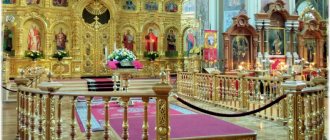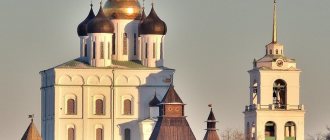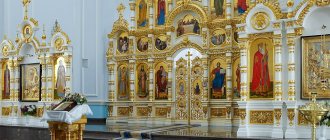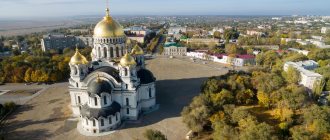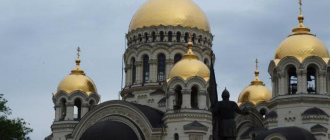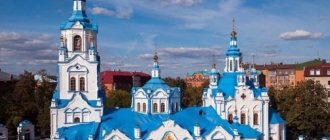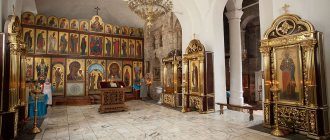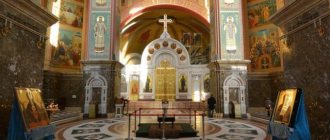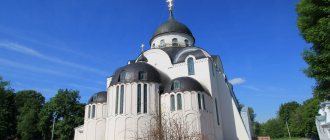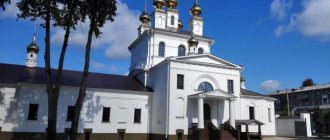On the high bank of the Moscow River you will see an unusually harmonious structure reaching into the sky - this is the Church of the Ascension in Kolomenskoye. The monument of ancient Russian architecture, erected in the 16th century, became the first tented church in Russia.
The exact date of foundation of the building has not been established, but it is known that its consecration took place in September 1532 during the reign of the Grand Duke of All Rus' Vasily III. Some historians believe that the temple was founded in honor of his son, the future ruler Ivan IV the Terrible, born two years before this event (for Vasily III, who crossed the fifty-year mark, the birth of an heir was an extremely important and happy event).
Description
The Church of the Ascension was built according to the design of the Italian architect Ivan Fryazin (Pietro Antonio Solari), who was working in Russia at that time. The site for the construction was chosen near the place where there was a healing spring, about which there are many legends.
According to one legend, St. George the Victorious (the most revered saint and great martyr in Christianity) chased a snake along the bottom of a ravine on a horse, and everywhere he galloped, springs appeared that healed diseases. The location of the temple is considered holy.
What historians are still puzzling over
Or maybe it was like this?
Now about the riddles. Although the church was built almost 500 years ago, in the years from 1528 to 1532, to this day disputes among historians do not cease about the exact date of its construction, about what year its construction began. Some historians claim that the temple is dedicated to a joyful event: the birth of Tsar Vasily’s third long-awaited son. That is, the future Ivan the Terrible has already been born, and a temple was erected in his honor.
But such a voluminous structure in those years simply physically could not have been built in just 2 years since the birth of Ivan (remember the lessons of history), since 1530. It is reliably known that the Church of the Ascension in the village of Kolomenskoye was completely built and solemnly consecrated in 1532.
Personal life of the king
That is why there is another version of those distant events. Construction began 2 years before the baby was born, and the temple had a slightly different purpose. Yes, it is connected with the birth of a child in the royal family, but... Initially, the temple was planned as a prayer place, they prayed for the birth of an heir to the royal couple.
But the fact was that Tsar Vasily was imposed a two-year penance. The Russian Tsar received this church punishment for bigamy. Because Vasily’s first wife did not give birth to a single child in their 20 years of marriage, and the tsar sent her to a monastery for this. And he quickly found himself another one. And so it turned out that the king turned out to be a bigamist - kings can do anything!
Although a monastery is not the worst option. If we consider that in Rus' a marriage could be dissolved only in the event of the death of one of the spouses, then guess which of the two royal persons it could be? Well, certainly not a husband. He's the king...
So, Vasily married for the second time. And for his first marriage, penance was imposed on him.
Architecture
The Church of the Ascension was one of the tallest buildings in the Moscow principality, its height is more than 60 meters and for a long time it served as a watchtower. The temple, located in the south of Moscow, was a good observation point on the southern border of the principality, from where danger most often threatened, primarily from Tatar-Mongol raids.
The Church of the Ascension is made in the form of a white stone tower with a high hipped roof, which was an innovation of that time. The tent has clear edges and is decorated with “diamond rustication” - a trim in the form of polyhedrons.
A smooth transition from one tier to another is made by rows of triple kokoshniks. The entrances to the temple are decorated with pointed elements - wimpergs.
The temple is surrounded by a two-tiered gallery with three amazing staircase-arches that fit perfectly into the surrounding area.
Currently, under the western porch there is an entrance to the basement, where an exhibition telling about the history of the temple is displayed. Here you will see photographs and documents, as well as interesting artifacts found by archaeologists.
In the basement of the temple, historians tried to find the famous library of Ivan the Terrible. It was he who was the last owner of valuable books and documents, the search for which has been going on for several centuries to no avail.
Here, in March 1917, the Sovereign Icon of the Mother of God was found, located in the Church of Our Lady of Kazan in Kolomenskoye. Her list is now kept in the basement of the temple.
Unique features of the temple
I'm not kidding at all about the one and only. This is true. Firstly, the Church of the Ascension is the oldest building on the vast territory of the Kolomenskoye park-reserve. She is about 500 years old!
Secondly, this was originally intended: the Church of the Ascension in Kolomenskoye was supposed to symbolize the Mount of Olives, where the Ascension of Christ took place. It is not for nothing that everyone who sees it is delighted with this elegant white stone creation, directed into the heavens. For example, the composer G. Berlioz from Paris called it “a miracle of miracles.”
Thirdly, this is the very first stone temple, during the construction of which the tent style of architecture was used. Before this construction, all temples and other religious buildings in Rus' were crowned with a dome or vault - a covering in the form of a hemisphere, and the Church of the Ascension was the first tented church in Russia. Its roof has the shape of a cone.
Interior decoration
The Church of the Ascension was a home summer church for the princely family and therefore its internal space is relatively small - about 100 square meters. meters. Thanks to the predominance of white color and the skillful placement of windows, the inside of the temple is very light and spacious.
Strict decorative decoration emphasizes the grandeur and harmony of the temple. Each element of the decor speaks of Peter Fryazin’s desire to show the lightness and upward aspiration of the structure, symbolizing the ascension of Christ into heaven.
The original painting, as well as the iconostasis of the first third of the 16th century, have not survived. The iconostasis that you will see was recreated in the 17th century from surviving ancient icons.
The temple was closed after the revolution. In 2000 it was re-consecrated. The reconstruction and reconstruction of the building was completed in 2007.
The Church of the Ascension of the Lord is the oldest architectural monument and a masterpiece of world architecture. In Russian architecture, perhaps, there is no more perfect structure in its forms and proportions.
The history of the creation of a white stone masterpiece
And it all started with the Pope
I don’t know exactly the conditions of this, to put it so roughly, punishment, but when 2 years of this penance had passed, he sent his ambassadors to the Pope with a request to send to the capital of the Moscow principality the famous Italian architect, namely, the prayer churches of Peter Anibale, or, as he was called in Russian chronicles, Peter Fryazin.
A funny story is connected with this surname. Some Italians, coming to Russian soil, encountered harsh weather conditions that were unusual for them. And then they often repeated the word “fre” or “frya,” which meant something like “it’s cold here.” Well, ours, without thinking twice, began to call them Fryazins.
At the very beginning of the summer of 1528, the future author of the Cathedral of the Ascension was already in Moscow, and after a few weeks he began to develop a plan for his construction.
Choosing a suitable place or Healing spring
The place for the future masterpiece of ancient Russian architecture was chosen on the high bank of the Moscow River, where there was a spring nearby that had long been revered by the people as miraculous.
According to legend, in these places, while fighting with a snake, St. George the Victorious galloped on his horse. And the horse’s hooves left holes on the ground, in which springs later appeared.
One of these miraculously appeared springs was called “Kadochka”. A log house with wooden tubs was placed above it, and everyone could draw healing water for themselves. She was especially famous for her ability to heal women from infertility. It is quite possible that this story is about this very source. Unfortunately, over time, he was buried, and not only him.
There was an error!
First, they laid the foundation in the shape of the letter “T”, as was necessary for the three-altar church. It was planned to install a belfry in the west. But when they completed laying the foundation, it turned out that the spring with which the plan was originally connected was not visible from the church and the temple was hidden from the spring by the high bank of the river.
Probably for some reason it was important to visually connect the building and the spring. Because this is precisely why the construction plan was changed. The builders were forced to place the church on a high basement, which had not previously been envisaged at all.
With the advent of the basement, a lot changed, and the entire layout had to be redone: the construction of the side aisles had to be canceled, and the belfry had to be moved to a new place, more consistent with the original idea.
And, of course, in order to go up to the second floor, it was necessary to design external stairs.
Fixed and built
Construction work began and was completed in 1532. It was 1532, as the chronicles say, that became the year of the creation of the beautiful tented temple.
Its height is 62 meters. It was perhaps the tallest building of its time. At one time it even served as a watchtower. Located near the southern border of the Moscow principality, the Church of the Ascension in the village of Kolomenskoye was a convenient observation point. After all, it was from the south at that time that danger often came, namely, Mongol-Tatar raids.
During construction work in connection with the birth of the heir to the throne, Ivan 4, according to tradition, a “royal seat” was built on a white stone base: a richly decorated throne with a carved back and a fresco above it.
Changes in the interior of the temple
The original interior of the temple, of course, has not been preserved. During numerous renovations, the floor tiles were partially restored and replaced, and the royal doors appeared, which are still on display to visitors.
Major renovations to the temple were carried out, it is believed, during the construction of the Catherine Palace. After that, several more were produced, and each time something was removed, and something new was added.
Chapel of the Ascension
This place was surrounded by a stone wall, which was built from the ruins of that same temple. In the resulting courtyard there is an octagonal round chapel. According to the pilgrim Bernard, an altar was built inside it, on which the liturgy was performed. Corinthian columns in the niches and Byzantine centaurs in the capitals are still preserved.
The area of the chapel courtyard is almost half of Imwomon. Silvia of Aquitaine, a famous pilgrim of the 4th century, wrote about him. And the pilgrim Arculf saw Imvomon (this happened in 670) and described it approximately as a large round church without a roof or vault, in the eastern part of which there is an altar under a narrow roof.
During archaeological excavations organized by archeology professor Virgilio Corbo in 1959, the diameter of the ancient church was determined from the remains of the foundation. It was approximately 25 meters. Arculf's descriptions were confirmed. The remains of Imwomon are preserved near the inner fence of the chapel.
Later, a Muslim mosque was built here - the Dome of the Ascension. The mosque's architectural elements resemble the shape of a Christian chapel. The keys to it are kept by the muezzin - the servant of the mosque.
Schedule
The Church of the Ascension, which is located on the vast territory of Kolomenskoye Park, operates according to the following schedule:
- from April 1 to September 30: Tuesday to Friday and Sunday - from 10 to 18. Saturday - from 11 to 19 hours. Monday is a day off;
- in other months - from October 1 to March 31 - only the exhibition in the basement is open. Everything is closed on Mondays. Other days - from 10 to 18 hours.
Due to the fact that the Church of the Ascension is not heated, during the cold season the entrance to the upper part of the building is closed to visitors; only the exhibition in the basement of the church is open. In the summer months, sightseeing tours in the main (upper) volume of the church are held for cathedral groups of visitors from June 1 to August 31 at 17.00 (on Saturdays, Sundays and holidays).
Ticket price for the exhibition:
- in the main building of the church: adults - 150 rubles, schoolchildren and pensioners - 50;
- a ticket to the exhibition in the basement of the Ascension Church costs 100 for adults, 50 rubles for schoolchildren and pensioners;
- For children under 6 years old and for full-time students of all universities of the Russian Federation, admission to the exhibitions is free.
Important tip! When planning a visit to the Kolomenskoye Nature Reserve, look for information on the Internet. In Moscow there are days of free admission to museums. It is on this day that it will be very beneficial to stroll through the park and its numerous exhibitions.
Coordinates of the Ascension Church in Kolomenskoye: 55.6673, 37.67069. It can be easily found on the three-dimensional plan of the reserve.
Near the belfry of the Ascension Cathedral, the St. George Church has been restored, inside of which there is a very interesting exhibition. On the territory of the park there is another unusual functioning church of the Kazan Icon of the Mother of God. Be sure to check it out!
On the map you can determine the exact location of the Ascension Church (click “+” or “-“ to zoom in or out the image.
During this trip to Moscow, I booked accommodation near Kolomensky Park. It was the Intourist-Kolomenskoye Hotel, a very comfortable hotel with pleasant service. In addition, in Moscow you can easily rent an apartment or a room on Airbnb, or book a hotel in any other convenient location through Booking.
My walk through Kolomenskoye Park in Moscow and a visit to the unique Church of the Ascension of the Lord took place on April 8, 2018.
The map below shows other attractions of Moscow and the Moscow region that I was able to visit.
Share in the comments below which unusual churches related to Russian history you have visited and which of them made the greatest impression.
